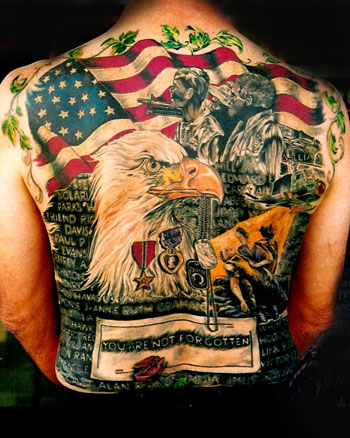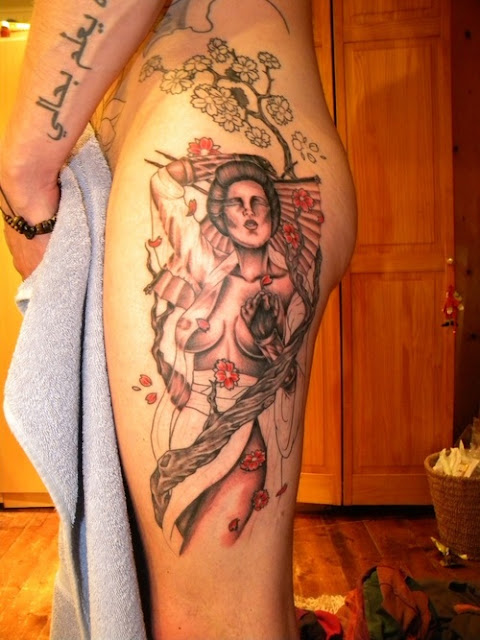
Tattoos have a history going back thousands of years, and very possibly tens of thousands. The earliest absolute evidence of tattoos is from the skin of a famous mummy who came to be known as Otzi. Otzi is a mummy who was found trapped in the glacial ice of the Alps in the early 1990s. Originally thought to be someone who died relatively recently, after further examination, he was found to be over 5000 years old. Among the many interesting things scientists learned about Otzi is that he had tattoos still visible on his mummified skin. Rather than the tattoos we expect to see in modern days such as symbols, animals and plantlife, Otzi's tattoos were mostly made of a series of lines. The lines were over areas in his body where the scientists also found evidence of arthritis or other painful conditions, so they believe that his tattoos may have been medicinal rather than ornamental.
 Long before Otzi was tattooed in the Bronze Age, there is evidence recovered during archaeological digs of probable tattoo implements as early as the Upper Paleolithic period (38,000 - 10,000 BC). These implements included red ochre, needles, and bone cups stained with ochre. Some figurines discovered from the same time period had designs on their skin, adding more circumstantial evidence to the belief that these very ancient people tattooed their skin.
Long before Otzi was tattooed in the Bronze Age, there is evidence recovered during archaeological digs of probable tattoo implements as early as the Upper Paleolithic period (38,000 - 10,000 BC). These implements included red ochre, needles, and bone cups stained with ochre. Some figurines discovered from the same time period had designs on their skin, adding more circumstantial evidence to the belief that these very ancient people tattooed their skin.
Moving forward in history, we also know that the ancient Egyptians tattooed themselves. The first tattooed Egyptians were from the Middle Kingdom period (2160-1994 BC). The most famous tattooed Egyptian mummy from that period was a priestess named Amunet, who was discovered in Thebes. Amunet had tattooed lines and dots arranged in ornamental patterns on her chest, back, pelvis and legs. The tattoos on her back and chest were patterns of necklaces, belts and collars that were clearly ornamental. The tattoos over her pelvis were believed to enhance fertility.
 In Ancient Rome, most tattoos weren't ornamental in nature, but were used in a much different way. Tattoos were used to track people who might otherwise be able to escape, desert or avoid identification. Slaves, prisoners, gladiators, Christians and mercenaries were all tattooed for these reasons. Soldiers, on the other hand, chose to be tattooed. Military tattoos were considered a great source of pride for the Roman soldier. Soldiers tattooed themselves to indicate their legion or unit and their rank, as well as for commemorative reasons such as for important battles or acts of bravery. The most common places for tattoos among Roman soldiers were on the face and the hands, presumably because the tattoos could be easily seen and their meanings quickly conveyed, but other areas of the body were often tattooed as well.
In Ancient Rome, most tattoos weren't ornamental in nature, but were used in a much different way. Tattoos were used to track people who might otherwise be able to escape, desert or avoid identification. Slaves, prisoners, gladiators, Christians and mercenaries were all tattooed for these reasons. Soldiers, on the other hand, chose to be tattooed. Military tattoos were considered a great source of pride for the Roman soldier. Soldiers tattooed themselves to indicate their legion or unit and their rank, as well as for commemorative reasons such as for important battles or acts of bravery. The most common places for tattoos among Roman soldiers were on the face and the hands, presumably because the tattoos could be easily seen and their meanings quickly conveyed, but other areas of the body were often tattooed as well.
Members of many other ancient societies also tattooed themselves for various reasons. If you are interested in learning more about the history of tattoos, some other societies who have an interesting tattoo history are the early societies of Great Britain and Western Europe, South America, and Asia and the Pacific Rim.
Military Tattoo Designs
 Long before Otzi was tattooed in the Bronze Age, there is evidence recovered during archaeological digs of probable tattoo implements as early as the Upper Paleolithic period (38,000 - 10,000 BC). These implements included red ochre, needles, and bone cups stained with ochre. Some figurines discovered from the same time period had designs on their skin, adding more circumstantial evidence to the belief that these very ancient people tattooed their skin.
Long before Otzi was tattooed in the Bronze Age, there is evidence recovered during archaeological digs of probable tattoo implements as early as the Upper Paleolithic period (38,000 - 10,000 BC). These implements included red ochre, needles, and bone cups stained with ochre. Some figurines discovered from the same time period had designs on their skin, adding more circumstantial evidence to the belief that these very ancient people tattooed their skin.Moving forward in history, we also know that the ancient Egyptians tattooed themselves. The first tattooed Egyptians were from the Middle Kingdom period (2160-1994 BC). The most famous tattooed Egyptian mummy from that period was a priestess named Amunet, who was discovered in Thebes. Amunet had tattooed lines and dots arranged in ornamental patterns on her chest, back, pelvis and legs. The tattoos on her back and chest were patterns of necklaces, belts and collars that were clearly ornamental. The tattoos over her pelvis were believed to enhance fertility.
 In Ancient Rome, most tattoos weren't ornamental in nature, but were used in a much different way. Tattoos were used to track people who might otherwise be able to escape, desert or avoid identification. Slaves, prisoners, gladiators, Christians and mercenaries were all tattooed for these reasons. Soldiers, on the other hand, chose to be tattooed. Military tattoos were considered a great source of pride for the Roman soldier. Soldiers tattooed themselves to indicate their legion or unit and their rank, as well as for commemorative reasons such as for important battles or acts of bravery. The most common places for tattoos among Roman soldiers were on the face and the hands, presumably because the tattoos could be easily seen and their meanings quickly conveyed, but other areas of the body were often tattooed as well.
In Ancient Rome, most tattoos weren't ornamental in nature, but were used in a much different way. Tattoos were used to track people who might otherwise be able to escape, desert or avoid identification. Slaves, prisoners, gladiators, Christians and mercenaries were all tattooed for these reasons. Soldiers, on the other hand, chose to be tattooed. Military tattoos were considered a great source of pride for the Roman soldier. Soldiers tattooed themselves to indicate their legion or unit and their rank, as well as for commemorative reasons such as for important battles or acts of bravery. The most common places for tattoos among Roman soldiers were on the face and the hands, presumably because the tattoos could be easily seen and their meanings quickly conveyed, but other areas of the body were often tattooed as well.Members of many other ancient societies also tattooed themselves for various reasons. If you are interested in learning more about the history of tattoos, some other societies who have an interesting tattoo history are the early societies of Great Britain and Western Europe, South America, and Asia and the Pacific Rim.
Military Tattoo Designs


















No comments:
Post a Comment